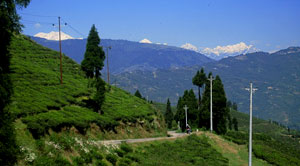 Janakpur is a historical city. It was the capital of an ancient state of Mithila. The name is derived from its king Janak who was father of Sita; it is one of the revered names in Hindu mythology. As the story goes she was married to Ram. Ram is revered as God in Hindu mythology and religion. Therefore the Janaki temple in Janakpur is the central attraction for all Hindus, especially devotees of Ram. The city remains in festive mood during the festival of Bibah (marriage) Panchami; it is celebrated annually to commemorate the marriage ceremony of Ram and Sita. Besides being a religious center it is well known for Mithili culture that extends far south in India.Dhankutta-Basantapur-Hille: The highway to the eastern border -Kakarbhitta turns north at Itahari -a small cross road town - to Dharan and Dhankutta. Dharan lies at the foothill where Terai (plain) starts. The road from this bustling city gradually climbs to Dhankutta. As you leave the hot plain the drive to this hill station is pleasant. The distance from Itahari to Dhankutta is 75 km. There are good view of the eastern Himalayan range on the ridge at Hille and lots of rhododendron flower in spring on Milke danda (hill) on way to Basantapur. Hille is 13 km from Dhankutta and Basantapur is 25km. The area is well known for recruiting of Gorkha soldiers from Rai and Limbu ethnic people. This area used to be important place east of Arun river known is Limbuan or Pallo (other side) Kirat, originally carved out as an autonomous kingdom within Nepal. They established Kirateshor dynasty in 7th century BC in Kathmandu and ruled for 1000 years. Their language is Tibeto-Burman; they worship ancestors. They have Mongoloid features.Tharu Village in Morang-Tarai: Tharus are first ethnic group to inhabit Terai when the entire plain was well known for Malaria spread by mosquito bite. Dhimal, Satar and Rajbanshi are other groups who have been living in this belt. Tharu and all other ethnic group in Terai have their own unique religion; like Kiratis they practice animism. Their physical features is Mongoloid.
Janakpur is a historical city. It was the capital of an ancient state of Mithila. The name is derived from its king Janak who was father of Sita; it is one of the revered names in Hindu mythology. As the story goes she was married to Ram. Ram is revered as God in Hindu mythology and religion. Therefore the Janaki temple in Janakpur is the central attraction for all Hindus, especially devotees of Ram. The city remains in festive mood during the festival of Bibah (marriage) Panchami; it is celebrated annually to commemorate the marriage ceremony of Ram and Sita. Besides being a religious center it is well known for Mithili culture that extends far south in India.Dhankutta-Basantapur-Hille: The highway to the eastern border -Kakarbhitta turns north at Itahari -a small cross road town - to Dharan and Dhankutta. Dharan lies at the foothill where Terai (plain) starts. The road from this bustling city gradually climbs to Dhankutta. As you leave the hot plain the drive to this hill station is pleasant. The distance from Itahari to Dhankutta is 75 km. There are good view of the eastern Himalayan range on the ridge at Hille and lots of rhododendron flower in spring on Milke danda (hill) on way to Basantapur. Hille is 13 km from Dhankutta and Basantapur is 25km. The area is well known for recruiting of Gorkha soldiers from Rai and Limbu ethnic people. This area used to be important place east of Arun river known is Limbuan or Pallo (other side) Kirat, originally carved out as an autonomous kingdom within Nepal. They established Kirateshor dynasty in 7th century BC in Kathmandu and ruled for 1000 years. Their language is Tibeto-Burman; they worship ancestors. They have Mongoloid features.Tharu Village in Morang-Tarai: Tharus are first ethnic group to inhabit Terai when the entire plain was well known for Malaria spread by mosquito bite. Dhimal, Satar and Rajbanshi are other groups who have been living in this belt. Tharu and all other ethnic group in Terai have their own unique religion; like Kiratis they practice animism. Their physical features is Mongoloid.
Day 01 : Arrive Katmandu
Day 02 : Departure from Katmandu to Janakpur by bus
Day 03 : Janakpur
Day 04 : Janakpur to Itahari by bus
Day 05 : Itahari to Ilam tea garden by bus
Day 06 : Ilam tea garden
Day 07 : Ilam to Phidim by bus
Day 08 : Phidim to Anbun Trekking home stay
Day 09 : Anubun to Taplejung Trekking Home Stay
Day 10 : Taplejung to Khamlalung Trekking Home Stay
Day 11 : Khamlalung to Terhathum Trekking Home Stay
Day 12 : Terhathum bus to Dhankuta Hile
Day 13 : Hille Rest day
Day 14 : Hile to Biratnagar
Day 15 : Biratnagar fly to Katmandu
Day 16 : Katmandu sightseeing to Nagarkot
Day 17 : Nagarkot to Katmandu
Day 18 : Departure
Itinerary II
Day 01 : Arrive Katmandu
Day 02 : Katmandu to Janakpur by Flight
Day 03 : Janakpur
Day 04 : Janakpur to Itahari by bus
Day 05 : Itahari to Ilam tea garden by bus
Day 06 : Ilam tea garden
Day 07 : Ilam to Phidim by bus
Day 08 : Phidim to Anbun Trekking .
Day 09 : Anubun to Taplejung Trekking.
Day 10 : Taplejung to Khamlalung Trekking.
Day 11 : Khamlalung to Terhathum Trekking .
Day 12 : Terhathum bus to Dhankuta Hile
Day 13 : Hille Rest day
Day 14 : Hile to Biratnagar
Day 15 : Biratnagar
Day 16 : Biratnagar to Chitwan National Park
Day 17 : Chitwan
Day 18 : Chitwan National Park to Lumbini
Day 19 : Lumbini to Tansen
Day 20 : Tansen to Pokhara
Day 21 : Pokhara sightseeing
Day 22 : Pokhara fly to Katmandu
Day 23 : Katmandu sightseeing
Day 24 : Katmandu Departure